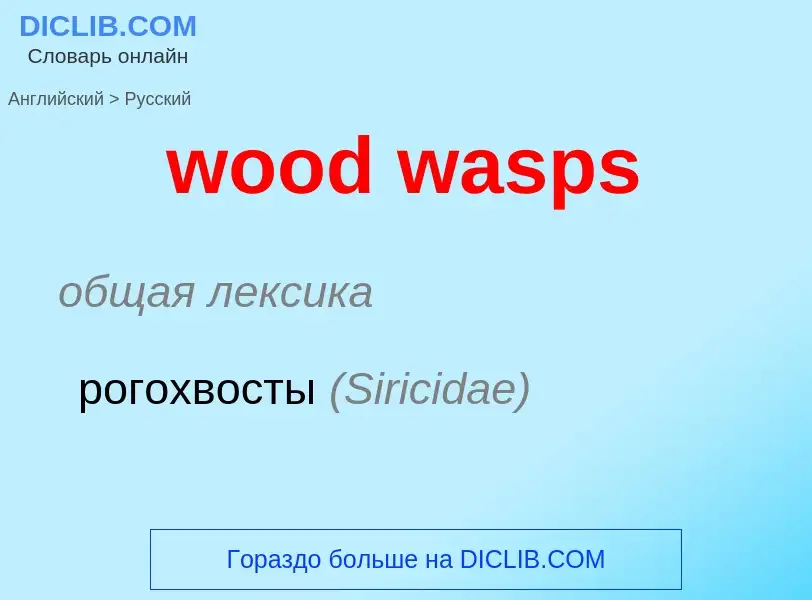Translation and analysis of words by ChatGPT artificial intelligence
On this page you can get a detailed analysis of a word or phrase, produced by the best artificial intelligence technology to date:
- how the word is used
- frequency of use
- it is used more often in oral or written speech
- word translation options
- usage examples (several phrases with translation)
- etymology
wood wasps - translation to russian
общая лексика
рогохвосты (Siricidae)
['wudwɔsp]
энтомология
жук-рогохвост (Sirex gen.)
существительное
энтомология
жук-рогохвост (Sirex gen.)
['hɔ:nteil]
энтомология
рогохвост хвойный (Sirex)
рогохвосты (Siricidae)
рогохвост (Sirex)
существительное
энтомология
рогохвост (Sirex)
Definition

Wikipedia
.jpg?width=120)
Horntail or wood wasp are any of the 150 non-social species of the hymenopteran family Siricidae, a type of wood-eating sawfly. The common name "horntail" derives from the stout, spine-like structure at the end of the adult's abdomen, which is used to pierce the host's bark to allow the eggs to be inserted into the wood (the ovipositor is typically longer and also projects posteriorly, but it is not the source of the name). A typical adult horntail is brown, blue, or black with yellow or red parts, and may often reach up to 4 cm (1.6 in) long. The pigeon horntail (Tremex columba) can grow up to 5 cm (2.0 in) long (not counting the ovipositor), among the longest of all Hymenoptera.
This family was formerly believed to be the sole living representative of the superfamily Siricoidea, a group well represented in Paleogene and Mesozoic times, but the family Anaxyelidae has been linked to this group as well. Siricidae has two subfamilies, Siricinae and Tremecinae. Siricinae infest needle-leaved trees and Tremecinae infest broad-leaved trees. There are ten living genera placed in the family, and an additional three genera described from fossils.
Female horntails lay their eggs in trees. The larvae bore into the wood and live in the tree for up to two years, possibly more. They typically migrate to just under the bark before pupation.

.jpg?width=200)
![counterpart]]).<br/>[[Ypresian]] [[Klondike Mountain Formation]] counterpart]]).<br/>[[Ypresian]] [[Klondike Mountain Formation]]](https://commons.wikimedia.org/wiki/Special:FilePath/SR UI 99-97-08 B Eourocerus anguliterreus 2015-04-17 img1a.jpg?width=200)
![''[[Sirex noctilio]]'' ("[[Sirex woodwasp]]") from [[New Zealand]], on ''[[Pinus radiata]]''. The spiral groove on the ovipositor is visible. ''[[Sirex noctilio]]'' ("[[Sirex woodwasp]]") from [[New Zealand]], on ''[[Pinus radiata]]''. The spiral groove on the ovipositor is visible.](https://commons.wikimedia.org/wiki/Special:FilePath/Sirex noctilio Pinus radiata.jpg?width=200)
